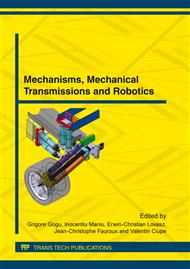[1]
I. Drăghici, Machine parts design, vol II, Ed. Tehnica Bucuresti, (1981).
Google Scholar
[2]
F.G., Kollmann, Welle-Nabe-Verbindungen. Gestaltung, Auslegung, Auswahl, Springer-Verlag, Berlin, (1984).
DOI: 10.1007/978-3-642-61727-0_6
Google Scholar
[3]
S. B. Leen, T. R. Hyde, E. J. Williams, A. A. Becker, R. McColl, T. H. Hyde and J. W. Taylor, Development of a representative test specimen for frictional contact in spline joint couplings, The Journal of Strain Analysis for Engineering Design January 1, 2000, 35, 521-544.
DOI: 10.1243/0309324001514279
Google Scholar
[4]
W. Krause, Konstruktionselemente der Feinmechanik, Carl Hanser Verlag, München Wien, (1993).
Google Scholar
[5]
W. Matek, Roloff / Matek Maschinenelemente, 14 Auflage, Vieweg Wiesbaden (2000).
Google Scholar
[6]
D. Mărgineanu, Load distribution on the joint's length due to the finite rigidity of the joint's elements, The VII-th MTM Symposium, Timisoara (1996).
Google Scholar
[7]
D. Mărgineanu, Spline Joints Rigidity, The 8-th Symposium on Mechanisms and Mechanical Transmissions, Vol. II, Timisoara, (2000).
Google Scholar
[8]
G. Niemann, Maschinenelemente, Springer-Verlag, Berlin, (1973).
Google Scholar
[9]
R. A. Adey, J. Baynham and J. W. Taylor, Development of analysis tools for spline couplings, Proceedings of the Institution of Mechanical Engineers, Part G, Journal of Aerospace Engineering, June 1, 2000, vol. 214, 6, 347-357.
DOI: 10.1243/0954410001531935
Google Scholar
[10]
J. E. Shigley, Mechanical engineering design, Mc Graw Hill, New York, (1972).
Google Scholar
[11]
R. A. Adey, Modeling and Simulation of Spline Couplings, IMechE Transmission seminar, June, (1999).
Google Scholar
[12]
M. Balekics, Tribology, Friction, Ed. Todesco, Cluj-Napoca, (2000).
Google Scholar
[13]
I. V. Kragelsky, Tribology Handbook, Mir Publishers Moscow, (1981).
Google Scholar
[14]
A. Barrot, M. Sartor, M. Paredes, Investigation of torsion teeth stiffness and second moment of area calculations for an analytical model of spline coupling behavior, Proceedings of the Institution of Mechanical Engineers, Part C, Journal of Mechanical Engineering Science, June 1, 2008 vol. 222, 6, 891-902.
DOI: 10.1243/09544062jmes828
Google Scholar
[15]
A. Barrot, M. Paredes, and M. Sartor, Determining both radial pressure distribution and torsional stiffness of involute spline couplings, Proceedings of the Institution of Mechanical Engineers, Part. C, Journal of Mechanical Engineering Science, December 1, 2006 vol. 220, 12, 1727-1738.
DOI: 10.1243/0954406jmes285
Google Scholar


